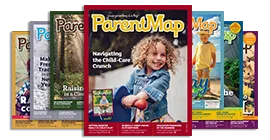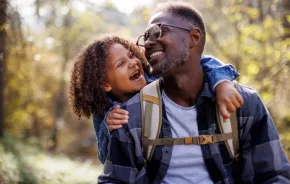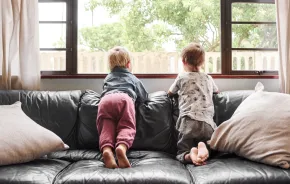
Photo:
iStock
My son came home from school feeling upset — again. His “best friend” ignored him at lunch, threw rocks at him at recess and made fun of his sweatshirt. These things seemed to be happening more and more, and I was starting to worry. This friendship was starting to feel more harmful than healthy. Yet my son said he still wanted to play with this friend all the time. What was going on?
I wanted to help my son recognize the signs of his unhealthy, toxic friendship and encourage him to build other, more positive relationships. But how?
I was lucky enough to talk with two local experts — Laura Kastner, Ph.D., a clinical psychologist and clinical professor of psychiatry and behavioral sciences at the University of Washington; and Julietta Skoog, Ed.S., a certified advanced positive discipline trainer — about toxic friendship. They shared invaluable information and advice about how to identify what a toxic friendship is (and isn’t), signs that your child might be experiencing one, and how to help them navigate those tricky waters and build valuable life skills along the way.
What is a toxic friendship?
Relationships are complicated, for adults and kids. We all grow and change, and even the closest friendships have moments (or seasons) of unhappiness. Sometimes we are even drawn toward relationships with a “frenemy,” someone who is a friend but also a rival. (Think of Jim and Dwight from “The Office.”) But a toxic friendship goes far beyond that.
“A toxic relationship implies mutual harm,” says Kastner. She explains that in a toxic friendship, parents may notice “manipulation, control and a negative impact on well-being for at least one person, usually both. At least one feels undermined, unsupported, constantly criticized. These traits are generally the same for all ages, but tend to get more sophisticated with age.”
This is different from bullying, which Kastner says is generally defined as “a relationship of torment over time between two people with unequal power.” Unlike bullying, she says, a toxic friend can build you up and include you, and often you want to be around that friend. But there is also degrading, undermining behavior along the way.
Is my child experiencing a toxic friendship?
Kids are growing and learning all the time, about all aspects of life, friendship included. So it’s natural for kids to make mistakes or hurt a friend’s feelings; that’s just part of growing up. Kastner says kids are exploring power dynamics from an early age, and some social cruelty is normal and expected. But one key to identifying a toxic friendship is the “frequency, intensity and pattern” of how these negative aspects of friendship are being used.
Changes in behavior are an indicator that parents should pay attention to if they think their child might be involved in a harmful friendship. Skoog says to watch for indicators such as your child “not sleeping very well, or not eating, or if they used to love going to the park after school and suddenly they want to go home right away. Or if they suddenly don’t want to participate in a sport they used to love so much.” Other signs that your child is dealing with a toxic friendship might include your child no longer knowing what they want to wear (out of fear they will be made fun of), or telling you they can’t be friends with someone because it’s “not allowed.”
What parents can do to help
The thought of a child experiencing a toxic friendship is scary, but luckily, there are lots of things parents can do to help their children navigate these rough waters and learn important life skills, as well.
Reading recommendations from Julietta Skoog:
- Talking to kids about friendships (blog post for parents)
- “The Not So Friendly Friend” (book for kids ages 4–7)
- “A Friend Like You” (book for kids ages 5–8)
Be curious
When you are watching your child experience a toxic friendship, it is easy to jump to conclusions about the other child involved. But demonizing the other child will never help you understand what is going on in the friendship, or why your child is continuing to engage in it. Kastner recommends stepping back, looking at the friendship and asking, “I wonder what the attraction is?” Why does the child who is being toxic want to hang around and be friends with your child? What is it about this toxic friend that is keeping your child attached to the relationship?
There are likely many factors, and you might not have the information to truly understand them all, but start from a place of curiosity and empathy. “Curious and not critical. The moment you malign their friend, it’s over,” says Kastner.
Ask questions
When it comes to understanding friendship dynamics, Kastner says that parents should “always ask questions, never advise kids.” If your child knows that you don’t like their friend, or you display a big emotional reaction to something they tell you, they will become much less likely to share things with you in the future. Try not to be anxious or reactive; your goal is to gather as much information as you can, and big emotional reactions that shut down communication are not helpful. “The exact thing you want, to keep an open door for interviewing or problem solving, will close when they know you are upset or distraught,” says Kastner.
Ask your child questions about how the friendship feels, how are they weighing the pros and cons in the relationship. Try to stay as neutral as possible.
For example, when my son was dealing with a challenging friendship in elementary school, I would ask him how his other friends treated him. Did his other friends throw rocks at him at recess? Did they yell at him when he tried to play with other kids? When he said no, we talked about what that might mean, how he felt about the way his other friends treated him compared to how the toxic friend made him feel. Those conversations helped him see the behavior he liked to receive from friends, as well as to identify what he did not enjoy. Skoog says, “Through curiosity, let kids decide for themselves if the friendship isn’t right for them.”
Try not to be anxious or reactive; your goal is to gather as much information as you can, and big emotional reactions that shut down communication are not helpful.
Listen, listen, listen
It is so difficult to watch your child struggle, especially when their struggles may mirror similar ones from your own childhood. Middle school was a fraught time for me when it came to friendships. Watching my own kids struggle through those murky waters was gut-wrenching. I wanted to shout, “No! Not that! Do this!” with the hope of keeping them from experiencing some of the pain I remember.
“So often, we try to go into fix-it mode,” says Skoog, “but there has to be this period of observation, curiosity — of truly listening, really listening to them, before accessing all of these tools and strategies.”
If we come in too fast and hard with solutions and help, we are robbing kids of the opportunity to learn how to navigate challenging relationships, a life skill many adults are still working on.
Talk through the friendship
It’s often helpful to talk through a tough situation, and friendships are no exception. Ask your child what the pros and cons of the friendship are. Do they think the pros outweigh the cons? Or are the cons harsh and harmful enough to outweigh the pros? Let your child know it’s normal for these things to change, and for friendships to have ups and downs. Make sure they know you are open and available to talk whenever they need to.
Skoog likes to talk about friendships as a roller coaster: They have many ups and downs over time, periods when you will feel connected or disconnected with your friend. She draws a “friendship timeline” and walks through these times of connection and disconnection to help children see these patterns.
“I love being able to draw out the friendship timeline, because it feels less intense than talking and more objective. Then I lean into curiosity and emotions so they can begin to think for themselves and grow their own reflection skills about the pattern of a relationship,” Skoog wrote in her blog post “Talking to kids about friendships.”
Another great tool for helping your child deal with a toxic friendship is to role-play. When the hard moments come up with friends, you are probably not going to be there. Role-play helps give your child tools and strategies so they are ready to face tough moments without you.
Parents can help minimize the harm of a toxic friend simply by providing other positive social interactions and experiences.
Provide positive social experiences
While telling your child they are not allowed to hang out with the toxic friend will likely result in a backlash, you can provide other opportunities for positive social engagement. Invite family friends over for dinner and game night. Go on a family hike. Sign your child up for a sports team or other group activities. Parents can help minimize the harm of a toxic friend simply by providing other positive social interactions and experiences.
While this is eminently easier to do with elementary-age children, parents can help provide positive social experiences for older kids, too. Offer to drive them and a few friends to a movie theater, or splurge and get a few tickets to a Seattle Sounders or Storm game. The goal is to “make a good day for them in another social sphere,” says Kastner.
Empower them to seek help or take a break
We all want our kids to learn independence and how to advocate for themselves. If the toxic friendship is showing up at school and your child wants support, encourage them to reach out to their teacher or school counselor. “When you can empower kids to talk to the teacher or ask for help, that’s skill building,” says Skoog. If they are too young to reach out themselves, parents can take this step to help kids get the support they need.
Sometimes, a friendship break is the best decision. This does not need to be a big dramatic breakup with the friend, and no one needs to be made into a villain. Sometimes it’s just the way life goes, and Skoog’s language of connection and disconnection provides a helpful touchpoint. Sometimes these disconnections will happen naturally, especially with a social change, such as the end of a school year or sports season. By providing the other positive social experiences previously mentioned, you can help your child deepen connections with other friends and lessen the impact of disconnecting from their toxic friend.
Set firm boundaries when necessary
Sometimes a strong boundary needs to be set, especially if illegal or dangerous behaviors are starting to show up in the toxic friendship. For example, if your child and their friend are caught with drugs or alcohol, it might be time to take a break from seeing that friend outside of school. Will your child be mad and fight this decision? Probably, but that’s okay. Be confident in your decision and tell them you can reassess in a few months. This does not have to be a lifetime ban on a friend, but sometimes a break is necessary when there are known dangerous behaviors.
Even if your tween or teen is upset by your decision, it’s possible that they are secretly relieved, too. Many kids get stuck in social groups and behaviors that they do not know how to get out of, and having those options simply taken away from them can come as a relief, whether they tell you or not.
As parents, watching your child experience a toxic friendship can feel scary. We want to protect them, to fix things. But learning how to navigate hard situations and relationships is a valuable skill, and by supporting our kids, rather than solving problems for them, we are giving them a gift.
“Let go of the control,” Skoog says. “Let it be messy by allowing kids to practice, to make mistakes, to mess up, and try again. This is what growing is all about.”











